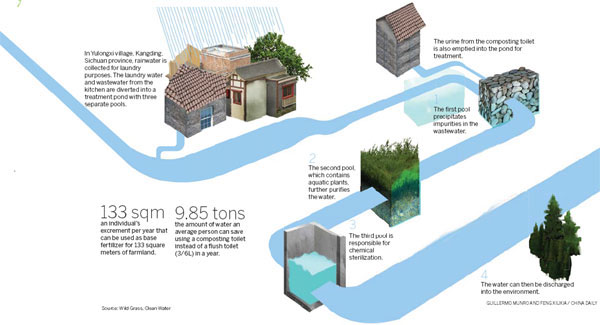Big problems in smallest room
Updated: 2013-05-15 09:33
By Xu Wei and Sun Ruisheng (China Daily)
|
||||||||

"It was the number one issue that needed to be solved," says Zhang Anmeng, secretary-general of the China Ancient Village Conservation and Development Committee.
"It was also a matter of respect to tourists, especially when you are charging entrance fees."
Zhang, who has visited more than 100 ancient villages across China, says Hougou village is not alone in facing the toilet problem as these historical sites open up to tourists. But it is unique in one sense - the fact that Hougou is on the arid loess plateau means flush toilets are not an option.
Many of the cave houses were built into the hills and the construction of a sewage system is not possible without major difficulties.
"A key question was how to dispose of the waste. It would pollute the rivers as there is no sewage treatment plant nearby," Hou says.
In the past, toilets in Hougou households were simple pits that used a large container in the ground to collect human excrement. Some were open-air outhouses that only allowed privacy if the user was squatting down.
Convincing villagers to abandon time-honored habits was also not easy and the village committee had to hold several meetings to convince the residents.
In 2009, the first solution to the toilet problem in the village was brought in by Beijing-based non-government organization Clean Water, which provided funding and technical aid at the request of the China Ancient Village Conservation and Development Committee and the tourism authority of Jinzhong city.
As an alternative to flush toilets, Clean Water proposed a composting toilet system, which separates liquid from solid waste with two buckets, using plant ash to absorb the liquid and reduce the odor of the excrement.

 'Taken 2' grabs movie box office crown
'Taken 2' grabs movie box office crown
 Rihanna's 'Diamonds' tops UK pop chart
Rihanna's 'Diamonds' tops UK pop chart
 Fans get look at vintage Rolling Stones
Fans get look at vintage Rolling Stones
 Celebrities attend Power of Women event
Celebrities attend Power of Women event
 Ang Lee breaks 'every rule' to make unlikely new Life of Pi film
Ang Lee breaks 'every rule' to make unlikely new Life of Pi film
 Rihanna almost thrown out of nightclub
Rihanna almost thrown out of nightclub
 'Dark Knight' wins weekend box office
'Dark Knight' wins weekend box office
 'Total Recall' stars gather in Beverly Hills
'Total Recall' stars gather in Beverly Hills
Most Viewed
Editor's Picks

|

|

|

|

|

|
Today's Top News
Shenzhou X astronaut gives lecture today
US told to reassess duties on Chinese paper
Chinese seek greater share of satellite market
Russia rejects Obama's nuke cut proposal
US immigration bill sees Senate breakthrough
Brazilian cities revoke fare hikes
Moody's warns on China's local govt debt
Air quality in major cities drops in May
US Weekly

|

|








